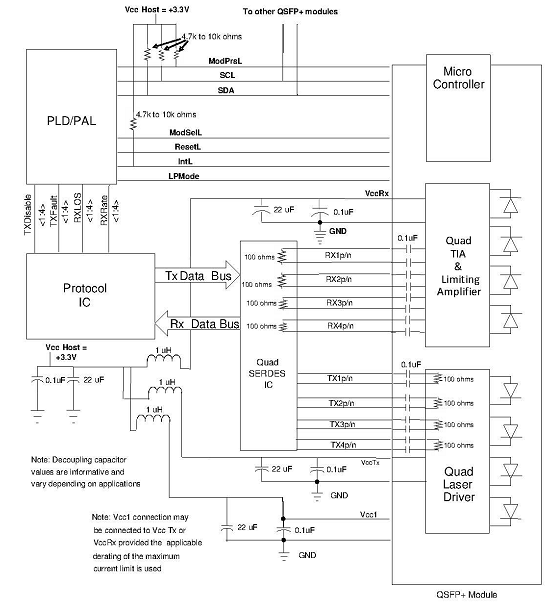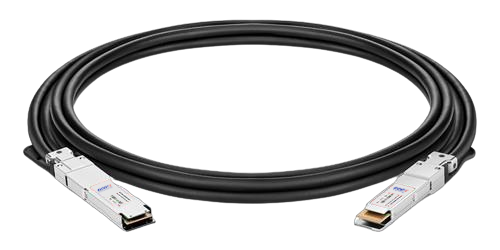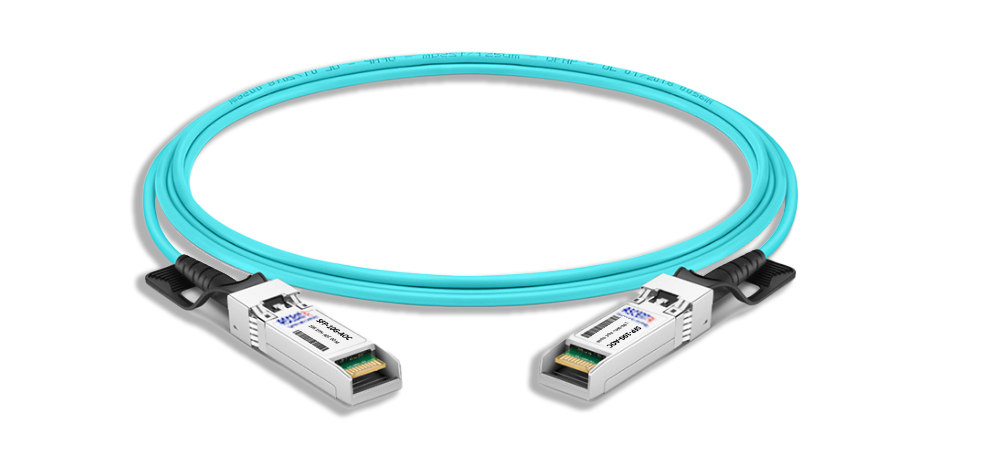- FIBER OPTIC TRANSCEIVERS >Optical Cables and Accessories >QSFP+ 40G AOC Cable

QSFP+ 40G AOC Cable
ASCENT 40G QSFP+ Active Optical Cable is a high-performance integrated cable suitable for high-speed core network and data center applications.
ã Full duplex 4 channel 850 nm parallel active optical cable
ã Up to 11.1 Gbps data rate per channel
ã Maximum link length of 300m links on OM3 multi-mode fiber
ã High-reliability 850 nm VCSEL technology
ã Electrically hot-pluggable
ã < 1.5 W power dissipation per cable end
ã QSFP+ MSA compliant
ã RoHS compliant
ã Case operating temperature range: 0 ô¯C to +70 ô¯C
Absolute Maximum Ratings
Parameter | Symbol | Value | Notes |
Storage Temperature | Ts | ã40 ô¯C to 85 ô¯C | |
Relative Humidity | RH | 5 % to 95 % | |
Power Supply Voltage | Vcc | ã0.3 V to 4.0 V | |
Signal Input Voltage | Vcc ã 0.3 V to Vcc + 0.3 V |
Recommended Operating Conditions
Parameter | Symbol | Value | Notes |
Case Operating Temperature | Tcase | 0 ô¯C to 70ô¯C | Without air flow |
Power Supply Voltage | Vcc | 3.13 V to 3.46 V, 3.3 V typical | |
Power Supply Current | Icc | 450 mA maximum | Per cable end |
Data Rate | BR | 10.3125 Gbps | Each channel |
General Product Characteristics
Parameter | Value | Notes |
Module Form Factor | QSFP+ | |
Number of Lanes | 4 Tx /Rx | |
Maximum Aggregate Data Rate | 42.0 | |
Maximum Data Rate per Lane | 10.5 | |
Standard Cable Lengths | 3, 5, 7, 10, 50, 100 | 1 |
Protocols Supported | Typical applications include Infiniband, Fiber Channel, 40G Ethernet | |
Electrical Interface and Pinãout | 38ãpin edge connector | 2 |
Standard Optical Cable Type | Multiãmode ribbon fiber cable assembly, riserãrated | |
Maximum Power Consumption per End | 1.5 | |
Management Interface | Serial, I2Cãbased, 400 kHz maximum frequency | 3 |
Notes:
1. Please contact sales for other lengths
2. Pinãout as defined by the QSFP+ MSA
3. As defined by the QSFP+ MSA
Electrical Characteristics
Parameter | Symbol | Value | Notes |
Supply Voltage | Vcc1, VccTx, VccRx | 3.14 V to 3.46 V, 3.3 V typical | |
Supply Current | Icc | 450 mA maximum | |
Transmitter | |||
Differential Data Input Swing | Vin,pp | 180 mV to 1000 mV | 1 |
Single Ended Input Voltage tolerance | VinT | ã0.3 V to 4.0 V | |
Receiver | |||
Vout,pp | 300 mV to 850 mV | 2 | |
Singleãended Output Voltage | ã0.3 V to +4.0 V |
Notes:
1. AC coupled internally. See Figure 1 for input eye mask requirements. Selfãbiasing 100 öˋ differential input.
2. AC coupled with 100öˋ differential output impedance. See Figure 2 for output eye mask.

Figure 1 ã Transmitter Input Differential Signal Mask

Figure 2 ã Receiver Output Differential Signal Mask
Highãspeed Electrical Characteristics per Lane
ParameterãInputs | Symbol | Value | Notes |
Reference Differential Input Impedance | Zd | 100 öˋ | |
Termination Mismatch | öZM | 5% maximum | 1 |
Input AC Common Mode Voltage | 25 mV (RMS) maximum | ||
Differential Input Return Loss | SDD11 | 2, 0.01 GHz to 4.1 GHz | |
SDD11 | 3, 4.1 GHz to 11.1 GHz | ||
Differential to Common Mode Loss | SCD11 | ã10 dB maximum | 0.01 GHz to 11.1 GHz |
Jitter Tolerance (Total) | TJ | 0.40 UI | |
Jitter Tolerance (Deterministic) | DJ | 0.15 UI |
Notes:
1. See SFFã8431 section D.15 Termination Mismatch for definition and test recommendations
2. Reflection coefficient given by equation SDD11 (dB) < ã12 + 2 * SQRT(f), with f in GHz. See Figure 3.
3. Reflection coefficient given by equation SDD11 (dB) < ã6.3 + 13Log10(f/5.5), with f in GHz. See Figure 3

Figure 3 ã Maximum Transmitter Input and Receiver Output Differential Return Loss
ParameterãInputs | Symbol | Value | Notes |
Reference Differential Output Impedance | Zd | 100 öˋ | |
Termination Mismatch | öZM | 5 % maximum | |
Output AC Common Mode Voltage | 15 mV (RMS) maximum | ||
Differential Output Return Loss | SDD22 | 4, 0.01 GHz to 4.1 GHz | |
SDD22 | 5, 4.1 GHz to 11.1 GHz | ||
Common Mode Output Return Loss | SCC22 | 6, 0.01 GHz to 2.5 GHz | |
SCC22 | ã3 dB maximum | 2.5 GHz to 11.1 GHz | |
Jitter Tolerance (Total) | TJ | ||
Output Rise and Fall time (20 % to 80 %) | tRH, tFH | 24 ps minimum | |
Deterministic Jitter | DJOUT | 0.38 UI | 7 |
Total Jitter | TJOUT | 0.64 UI | 7 |
Notes:
4. Reflection coefficient given by equation SDD22 (dB) < ã12 + 2 * SQRT(f), with f in GHz. See Figure 3.
5. Reflection coefficient given by equation SDD22 (dB) < ã6.3 + 13Log10(f/5.5), with f in GHz. See Figure 3.
6. Reflection coefficient given by equation SCC22 (dB) < ã7 + 1.6 * f, with f in GHz.
7. When transmitter input jitter specs are met.


OSFP 800G ACC Cable
800G Twin-port 2x400G OSFP Active Copper Cable

OSFP 800G DAC Cable
800G Twin-port 2x400G OSFP Passive DAC Cable

800G OSFP to 4x200G Breakout ACC
800G 4x200G OSFP Breakout Active Copper Cable

400G OSFP to 400G QSFP-DD DAC
400G OSFP to 400G QSFP-DD Passive DAC Twinax Cable

400G OSFP to 4x100G QSFP56 DAC
400G OSFP to 4x100G QSFP56 Passive DAC Breakout Cable

400G QSFP DD DAC Cable
400G QSFP-DD Passive Direct Attach Copper Cable

400G QSFP DD to 4X100G QSFP56 AOC
400G QSFP-DD to 4x100G QSFP56 Active Optical Cable

400G QSFP DD to 4X100G QSFP28 AOC
400G QSFP-DD to 4x100G QSFP28 Active Optical Cable

400G OSFP to 2x200G QSFP56 AOC Breakout Cable
400G OSFP to 2x200G QSFP56 AOC Breakout Cable

400G QSFP DD AOC Cable
400G QSFP-DD Active Optical Cable

400G QSFP DD AOC Breakout Cable
400G QSFP-DD to 2x 200G QSFP56 Active Optical Breakout Cable

200G QSFP56 InfiniBand HDR AOC
200G QSFP56 to QSFP56 Active Optical Cable

200G QSFP56 PSM4 DAC
200G QSFP56 PSM4 Direct Attach Passive Copper Cables

QSFP28 100G AOC Cable
100 Gb/s QSFP28 Active Optical Cable

QSFP28 100G DAC Cable
100G QSFP28 Passive DAC Twinax Cable

QSFP AQ AOC 4G 10
40G QSFP+ to 4x10G SFP+ Transceiver

QSFP+ 40G DAC Cable
40G QSFP+ to QSFP+ Passive Copper Cable (PCC)

MTP/MPO Harness Assemblies
12/24 MTP/MPO LC Harness Cable Assembly

SFPP AT AOC Cable
10G SFP+ Active Optical Cable

100G to 25G Adapter
100G QSFP28 to 25G SFP28 Adapter

10G SFP+ Passive Copper Twinax Cable
SFPP-AT-DAC-2M 10G SFP+ Passive Direct Attach Copper Twinax Cable (PCC)

QSFP CVR 10G
QSFP to SFP/SFP+ Adapter Module
White Paper
Press Releases
Briefings 1
Briefings 2
Videos, etc.
QRG
Manual1
Manual2
Get in touch with our experts
Feedback